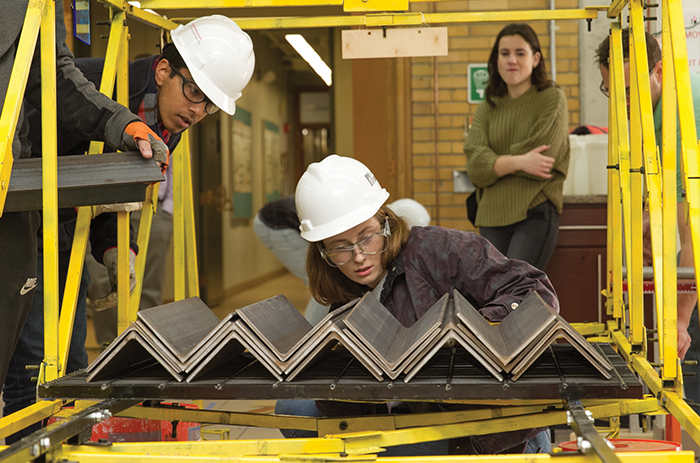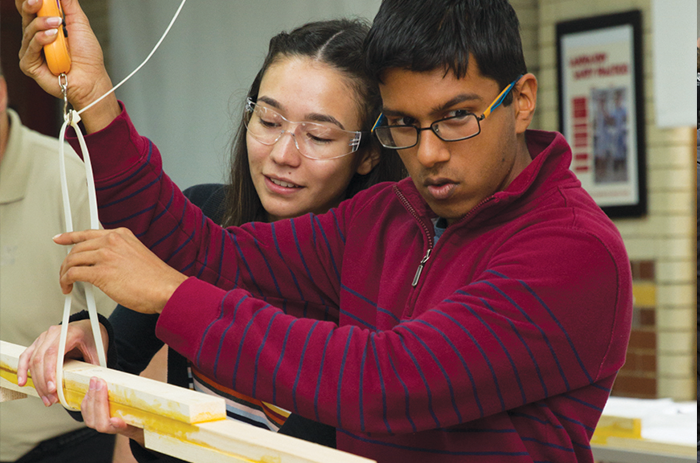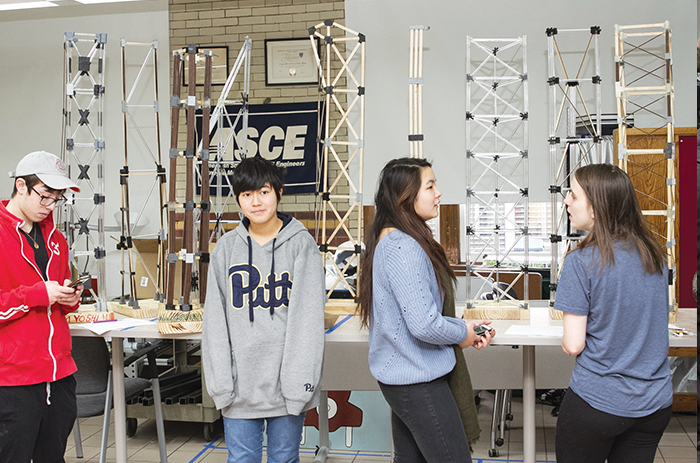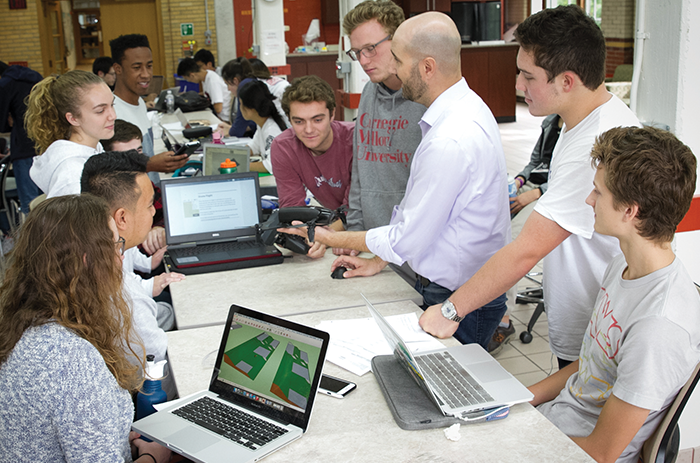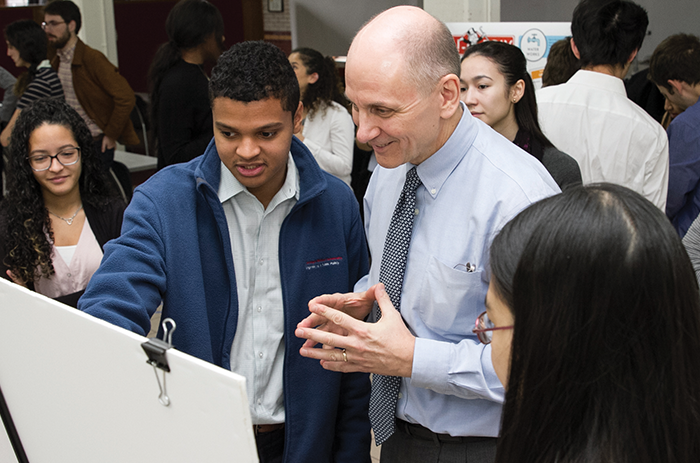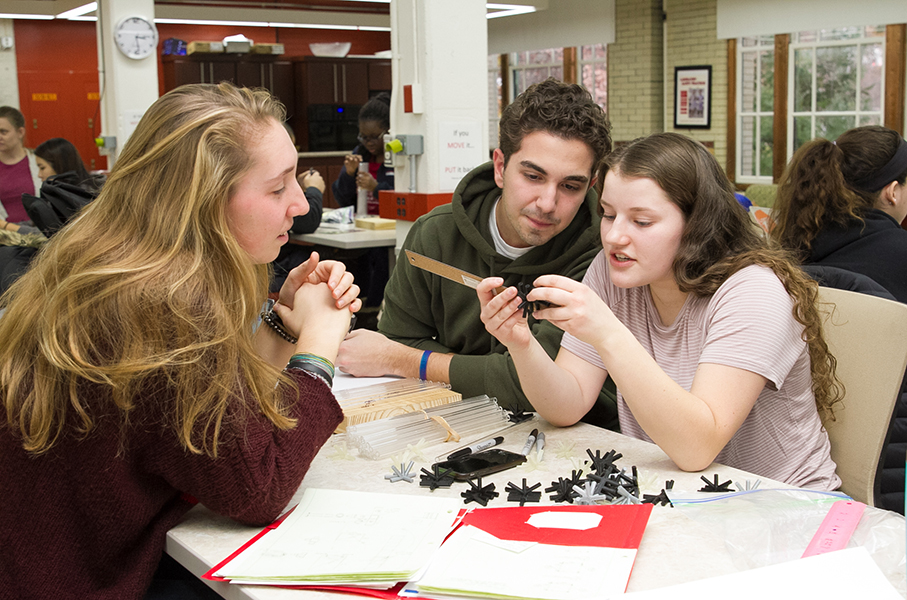
Learning by Doing
Hands-On Design Courses Equip Students for Success
Whether you’re designing infrastructure for transportation, buildings, water systems, or something entirely different, taking on your first project as a recently graduated civil or environmental engineer can be daunting. For starters, there is the multitude of objectives, the risk and uncertainty, the complex planning and scheduling constraints, and of course the challenge of learning to work and communicate within a team.
To build student skill and confidence in dealing with the complex milieu involved with real projects, the CEE undergraduate curriculum includes a project course in each of a student’s four years at Carnegie Mellon.
Together, these courses create the CEE “design thread” that provides students with opportunities across all four years to gain hands-on engineering experience and to apply what they’re learning in the core courses to actual projects.
“We want students to have exposure to open-ended problems and to get them more comfortable with the ambiguity that permeates real projects,” explains Department Head Dave Dzombak. “The design courses also give students exposure to the breadth of civil and environmental engineering. Each of the projects touches different areas of the
Learning the Design Process
The design thread starts for first-year students with Exploring CEE: Infrastructure and Environment in a Changing World. This course introduces students to areas such as structural engineering, construction project management, and environmental engineering. Additionally, they begin to learn about challenges related to working in teams, scheduling, evaluating risk, and ethical decision-making. They explore these topics through a variety of problem-solving exercises and group projects—from building a wooden truss that holds Professor Costa Samaras’ weight to using drones to collect information and inform construction decisions.
In their sophomore year, students delve more deeply, through textbook study, discussion, hands-on activities, and self-reflection, into learning the skills of design, teamwork, and graphic, oral, and written communication that they’ll need to succeed when working on bigger projects.
Professor Sarah Christian, who teaches the newly introduced sophomore course CEE Challenges: Design in a Changing World, says one of her main goals is teaching students how to define and approach open-ended and vague problems.
“You can’t always expect people to tell you what you need to do or have a book give you the answer. That’s not how engineers work in the real world,” she says. “You have to come up with and evaluate the ideas and answers on your own. You have to use your own judgment to decide when and how to apply various concepts and tools to solve a problem. Our goal is to give students a structure they can use for working through this self-guided design process.”
Communication and teamwork are also emphasized throughout her curriculum, and the students work with an entirely new group for each project. “Learning how to work effectively with teams is something that everyone struggles with throughout their careers,” says Christian, who shares tools with the students that they can use to make teams run more smoothly and effectively.
The close-knit CEE community is often among students’ favorite aspects of the department, and this opportunity to work closely with others in their cohort in their sophomore year helps students cement bonds to the department and their classmates early in their studies.
Christian says she’s already seen an effect. “I’ve noticed so many sophomores this year who didn’t know each other at the beginning of the Fall semester, who are now hanging around, walking the halls together, and doing their work together.”
Building on New Skills
The co-instructor of the junior-level CEE Projects: Designing the Built, Natural, and Information Environments, Professor Susan Finger, agrees that the earlier students can build teamwork skills, the better.
“When you have something big to accomplish, you can’t do it by yourself,” says Finger, who teaches the course with adjunct professor Donald Coffelt. “Everyone brings different backgrounds, interests, and strengths to a project. Those differences allow you to do more together than you could alone. By pooling everything you know, you become more successful as a team than you could be as an individual.”
Many aspects of the skills that students are now learning as sophomores had previously been taught in the junior CEE Projects course. For Finger, this means that the next class of junior students will have a head start and more opportunity to explore the technical aspects of the projects they’re assigned. They’ll also have many chances to practice and advance their design, communication, and teamwork skills.
The CEE Projects course focuses on teaching students what goes into completing large projects, from reviewing codes, standards, and engineering documents, to meeting with city planning commissions, to project safety management.
“We go through the whole process and show students all of the elements that must fall into place when you’re doing a big project, which comprises the vast majority of civil engineering projects,” she says.
To do this, students tackle three projects: a design-build project, a computing and sensing project, and an environmental project involving data analysis. They also explore engineering failures and what you learn when projects go wrong.
“My goal is that by the time they get to their senior year, they are skilled at working in teams and understand how a project comes
Tying Everything Together
The senior-level Civil and
After studying the rules, the students began the process of design, planning, and cutting, welding, and bolting materials together. At the end of the semester, the bridges were inspected and tested by Professor Jim Thompson.
“When you see the size and scale of these things, it’s impressive,” Thompson says. “I had some students this year stand back and look at what they did. All they could say was, ‘Wow, we did that.’”
The entire course is a chance for students to demonstrate mastery of not just their technical skills but their professional skills as well. As in the other design courses, Thompson says the open-ended nature of the project is something students must accept and manage.
“In this course and in any design course, there’s no single answer to the design challenge. Some answers are better than others, but there is a large set of valid answers. We saw three very different bridges from the three groups we had this year.”
It’s an experience Thompson believes is excellent preparation for entry into the field. “The purpose of the design thread is that, when they graduate, all CEE students have a really good understanding of what it means to design a project with consideration for associated constraints and limitations.”
As
“The CEE curriculum prepares students to be leaders in an ever-changing business and project environment,” he states. “We are equipping our students to be flexible, adaptable, and creative in addressing modern challenges in civil and environmental engineering.”
